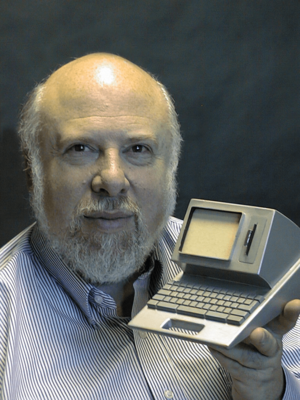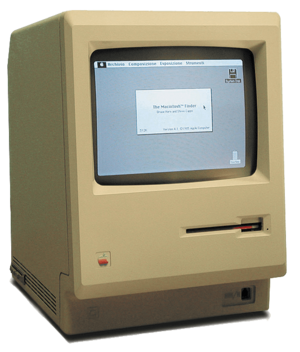Jef Raskin facts for kids
Quick facts for kids
Jef Raskin
|
|
|---|---|

Raskin holds a model of the Canon Cat in January 1999.
|
|
| Born | March 9, 1943 New York City, U.S.
|
| Died | February 26, 2005 (aged 61) Pacifica, California, U.S.
|
| Known for | human–computer interface expert |
| Spouse(s) | Linda S. Blum (m. 1982) |
| Children | 3 |
Jef Raskin (born Jeff Raskin; March 9, 1943 – February 26, 2005) was an American expert in how humans and computers interact. He is famous for coming up with the idea for the Macintosh computer project at Apple in the late 1970s and leading it at the start.
Contents
Early Life and Learning
Jef Raskin was born in New York City. He earned degrees in mathematics and physics from Stony Brook University. In 1967, he got his master's degree in computer science from Pennsylvania State University. His first computer program was a music application for his master's project.
Raskin later taught art, photography, and computer science at the University of California, San Diego (UCSD). He worked there from 1968 to 1974. He even showed off his collection of unique toys as art! He once announced he was leaving his teaching job by flying over the Chancellor's house in a hot air balloon.
He helped create a computer center that used newer 16-bit computers with screens, instead of the older teletype machines.
FLOW Programming Language
With his student Jonathan Collins, Raskin created a simple programming language called FLOW. It was made to teach programming to art and humanities students. This language had only seven commands and couldn't even work with numbers! It was designed to be very easy to use and learn.
Changing His Name
During this time, Jef changed the spelling of his first name from "Jeff" to "Jef." He liked how it had fewer extra letters.
Raskin also wrote for computer magazines like Dr. Dobb's Journal. He started a company called Bannister and Crun, named after characters from a British radio show.
Working at Apple
Writing for Apple
Jef Raskin first met Steve Jobs and Steve Wozniak, the founders of Apple, in their garage. This was after their Apple II computer came out. Jobs hired Raskin's company to write the Apple II BASIC Programming Manual. Raskin wrote a very clear manual that became a standard for the young computer industry.
Joining Apple's Team
In January 1978, Raskin officially joined Apple as the Manager of Publications. He was the company's 31st employee. He kept his computer science degree a secret at first. He worried that people in the early computer world, who were mostly hobbyists, might not like someone with an academic background.
Because he was in charge of documents and testing, Raskin had a big impact on early Apple projects. For example, he helped develop an 80-column display card for the Apple II. He also encouraged Apple to use the UCSD P-System operating system, which Apple later sold as Apple Pascal.
Raskin often wrote memos about how personal computers could become simple, everyday tools for everyone. He believed that computers like the Apple II were too complicated. He wanted to create a computer that was easy to use right from the start.
The Macintosh Project

In 1979, Raskin started the Macintosh project to bring his ideas to life. He hired former students and other talented people from Apple. He secretly got permission and money directly from Apple's top leaders, avoiding Steve Jobs. Raskin led the Macintosh project by himself for about the first year. He even chose the name "Macintosh" after his favorite type of apple.
Author Steven Levy said that Raskin had a powerful vision for a computer that would be affordable, very useful, and incredibly friendly to users.
Raskin's first prototype for the Mac was simple. It was similar to the Apple II in power, with a small 9-inch black-and-white screen and a floppy drive. It only showed text, as Raskin didn't like the computer mouse. He preferred users to keep their hands on the keyboard. The machine had basic programs built in. It could even guess what the user wanted to do. For example, if you started typing, it would switch to editor mode. If you typed numbers, it would switch to calculator mode.
In 1981, Steve Jobs became very interested in Raskin's Macintosh project. Jobs wanted to combine the easy-to-use ideas from Xerox PARC (which used a GUI with icons and windows) with Raskin's idea of a simple, affordable computer.
Raskin is known for being one of the first to show Jobs and the Lisa engineers the ideas from Xerox PARC. However, Raskin didn't like the mouse and thought it wasn't needed. He did, however, push for the Macintosh to use a one-button mouse, unlike PARC's three-button mouse.
Some people, like Andy Hertzfeld, a member of the Macintosh team, said that Raskin often claimed to have invented many technologies. Raskin's resume from 2002 even said he was the "Creator of Macintosh computer." While Raskin started and led the project for its first year, the final Mac product was very different from his original vision. Steve Jobs himself called the Macintosh a team effort.
Apple recognized Raskin's early role after he left the company. They gave him the one-millionth Macintosh computer, with a special engraved plaque.
After Apple: Information Appliances
Raskin left Apple in 1982. He started his own company, Information Appliance, Inc. His goal was to create the kind of simple, easy-to-use computers he had first imagined for the Macintosh.
His first product was the SwyftCard, a special card for the Apple II that had many programs built in. His company later made the Swyft, a stand-alone laptop computer. Raskin licensed this design to Canon, which released a similar desktop product called the Canon Cat in 1987. The Canon Cat had a very new and interesting way of working, but it didn't sell well.
Raskin wrote a book called The Humane Interface (2000). In it, he shared his ideas about how computers and humans should interact.
He also started a new computer interface project called The Humane Environment, or THE. In 2005, he renamed it Archy. This system used his ideas for a "humane interface" and a Zooming User Interface (ZUI), where you could zoom in and out of your work.
Jef Raskin's son, Aza Raskin, continues his father's work at a company called Humanized. They released a program called Enso, which is based on Jef's ideas.
Cognetics: The Ergonomics of the Mind
Raskin used the term "cognetics" to mean "the ergonomics of the mind." This means making computer interfaces easy for our brains to use. He believed that designing interfaces should be a careful engineering process, not just guesswork.
Raskin also suggested that we shouldn't call computer interfaces "intuitive." He said that things seem easy to use because we've seen similar systems before. So, he preferred the word "familiar" instead. He thought that aiming for "intuitive" designs might stop designers from creating new, better ways of doing things.
Other Interests
While Jef Raskin was best known for computers, he had many other interests! He conducted the San Francisco Chamber Opera Society and played various musical instruments, like the organ and the recorder. His artwork was even shown in famous museums like the Museum of Modern Art in New York.
He also had a patent for how to build airplane wings. He designed and sold radio-controlled model gliders. He was a skilled archer, target shooter, and bicycle racer. He loved music and composed his own pieces. He also wrote articles for many magazines, including Mac Home Journal, Forbes, and Wired. One of his favorite things was to play music with his children.
Raskin owned a small company called Jef's Friends, which made model airplane kits. He also designed toys, like a hanging cloth maze called Space Expander and interlocking wood blocks called Bloxes.
Personal Life
Jef Raskin married Linda S. Blum in 1982. They had three children: Aza, Aviva, and Aenea. In 1985, Raskin described his house as "practically one large playground," with secret doors and an auditorium. He said, "I decided when I grew up I was not going to give up the things I liked doing, and I've not."
Jef Raskin was diagnosed with pancreatic cancer in December 2004. He passed away in Pacifica, California, on February 26, 2005, at the age of 61.
See also
 In Spanish: Jef Raskin para niños
In Spanish: Jef Raskin para niños
- Information appliance

